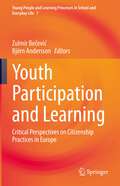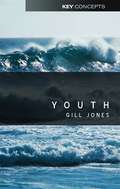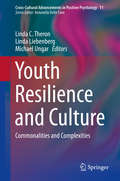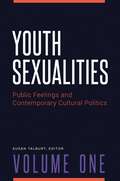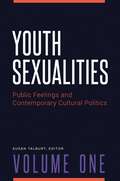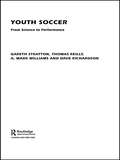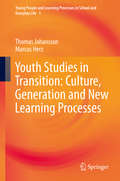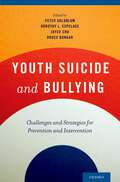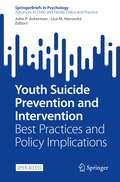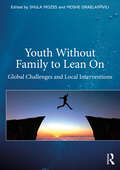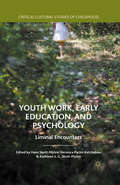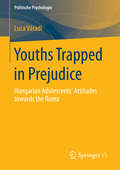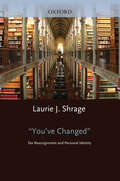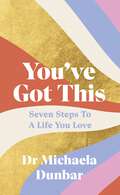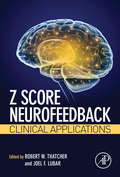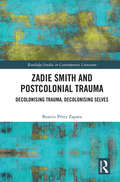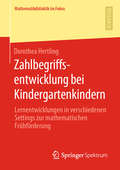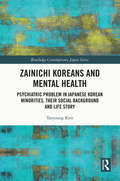- Table View
- List View
Youth Participation and Learning: Critical Perspectives on Citizenship Practices in Europe (Young People and Learning Processes in School and Everyday Life #7)
by Zulmir Bečević Björn AnderssonThis book contributes to the studies on learning processes occurring outside “traditional” socialization settings such as family and school, by analysing civic and political participation and learning experiences. In this perspective, the book delves into the connections between the concepts of learning and participation and, in various ways and from different perspectives, critically interrogates learning and participation as interrelated phenomena, with the aim of revealing complexities implicated in pathways to adulthood. Being interdisciplinary in its nature (contributors come from disciplinary backgrounds such as educational sciences, child and youth studies, social work, sociology and political science), the volume provides an up-to date analysis of contemporary issues connected to youth participation and learning. The work taps into central areas of everyday life of young people and youth meaning-making and generates and presents qualitative knowledge about what it means to be young in Europe today.
Youth (Key Concepts Ser. #16)
by Gill JonesThis accessible book takes a fresh and original approach to the concept of youth, placing changes in the social construction of "youth" within a more general story of the rise and fall of grand theory in social science. Gill Jones evaluates the current relevance of these wider social theories to understanding youth in late modernity in the light of key examples of empirical work on young people. Individual chapters are organized around the themes of action, identity, transition, inequality and dependence - conceptual themes which cross-cut young people's lives. The book considers the validity of youth as a social concept and examines ways of identifying what is specific to young people without resorting to seeing them as a homogeneous group defined by their age; in so doing, it uncovers notions which are erroneously attributed to young people.
Youth Resilience and Culture: Commonalities and Complexities (Cross-Cultural Advancements in Positive Psychology #11)
by Linda C. Theron Linda Liebenberg Michael UngarUntil researchers and theorists account for the complex relationship between resilience and culture, explanations of why some individuals prevail in the face of adversity will remain incomplete. This edited volume addresses this crucial issue by bringing together emerging discussions of the ways in which culture shapes resilience, the theory that informs these various studies, and important considerations for researchers as they continue to investigate resilience. Using research from majority and minority world contexts, ‘Youth Resilience and Culture: Commonalities and Complexities’ highlights that non-stereotypical, critical appreciation of the cultural systems in which youth are embedded, and/or affiliate with, is pivotal to understanding why particular resilience processes matter for particular youth in a particular life-world at a particular point in time. In doing so, this book sensitizes readers to the importance of accounting for the influence of cultural contexts on resilience processes, and to the danger of conceptualising and/or operationalising resilience, culture, and their interplay, simplistically or idealistically. In short, the progressive contents of ‘Youth Resilience and Culture: Commonalities and Complexities’ make it an essential read for resilience-focused scholars, students, academics, and researchers, as well as policy makers, practitioners, and humanitarian workers engaged with high-risk populations.
Youth Sexualities [2 volumes]: Public Feelings and Contemporary Cultural Politics [2 volumes]
by Susan TalburtThese volumes offer an in-depth analysis of youth sexualities as they shape and are shaped by public feelings and by American social, cultural, and political contexts.The idea of youth sexuality makes many adults anxious, but sexuality is a very real part of youth and is the subject of many important social issues. Society now increasingly, sometimes grudgingly, recognizes youth as sexual actors; this collection examines contradictory public feelings related to youth sexualities, including perennial and new topics such as sex education, sexting, teen mothers, masculinities, sexualization, popular culture, the increasing visibility of LGBTQ youth, and the digital world.The contributors examine the back-and-forth of adult and institutional concerns, policies, and practices as they both govern and are influenced by youths' sexual subjectivities, identities, actions, and activism. The first volume historicizes "official knowledge" and cultural constructions of youth sexualities; offers examples of the "framing" of youth through research, film, the media, and transnational NGOs; and foregrounds youths' experiences of sexuality in everyday life. The second volume considers adult and youth activism. Through first-person and analytical accounts, the book offers multiple perspectives of ways in which adult professionals, such as youth workers and researchers, can work side-by-side with youth rather than "above" or "in front of" them.
Youth Sexualities [2 volumes]: Public Feelings and Contemporary Cultural Politics [2 volumes]
These volumes offer an in-depth analysis of youth sexualities as they shape and are shaped by public feelings and by American social, cultural, and political contexts.The idea of youth sexuality makes many adults anxious, but sexuality is a very real part of youth and is the subject of many important social issues. Society now increasingly, sometimes grudgingly, recognizes youth as sexual actors; this collection examines contradictory public feelings related to youth sexualities, including perennial and new topics such as sex education, sexting, teen mothers, masculinities, sexualization, popular culture, the increasing visibility of LGBTQ youth, and the digital world.The contributors examine the back-and-forth of adult and institutional concerns, policies, and practices as they both govern and are influenced by youths' sexual subjectivities, identities, actions, and activism. The first volume historicizes "official knowledge" and cultural constructions of youth sexualities; offers examples of the "framing" of youth through research, film, the media, and transnational NGOs; and foregrounds youths' experiences of sexuality in everyday life. The second volume considers adult and youth activism. Through first-person and analytical accounts, the book offers multiple perspectives of ways in which adult professionals, such as youth workers and researchers, can work side-by-side with youth rather than "above" or "in front of" them.
Youth Soccer: From Science to Performance
by Thomas Reilly Dave Richardson Gareth Stratton A. Mark WilliamsAs the adult game has increased in popularity, youth soccer has also seen significant expansion in recent years. The popularity of the youth game is set to continue. Young boy and girl players wish to emulate professional soccer stars and the professional game, often with long-term financial rewards in mind, is increasingly keen to develop young talent. Applied sports science is now a well-established feature of the adult game but the sports science that supports modern football does not translate directly into the youth game. The coaches of young players need specific information about children. Themes explored in this text include: growth of physiological systems development of motor and perceptive skills paediatric environmental physiology prevention of injury diet and nutrition youth fitness and skills training effective teaching and coaching of juniors the role of football academies. Youth Soccer: From Science to Performance blends current child-focused sports science theory with youth-specific coaching practice to help create soccer development strategies for children. It promotes knowledge and understanding in all these areas and will further professional expertise amongst coaches who wish to develop the all year round potential of youth soccer players and train the stars of the future.
Youth Soccer: From Science to Performance
by Thomas Reilly Dave Richardson Gareth Stratton A. Mark WilliamsAs the adult game has increased in popularity, youth soccer has also seen significant expansion in recent years. The popularity of the youth game is set to continue. Young boy and girl players wish to emulate professional soccer stars and the professional game, often with long-term financial rewards in mind, is increasingly keen to develop young talent. Applied sports science is now a well-established feature of the adult game but the sports science that supports modern football does not translate directly into the youth game. The coaches of young players need specific information about children. Themes explored in this text include: growth of physiological systems development of motor and perceptive skills paediatric environmental physiology prevention of injury diet and nutrition youth fitness and skills training effective teaching and coaching of juniors the role of football academies. Youth Soccer: From Science to Performance blends current child-focused sports science theory with youth-specific coaching practice to help create soccer development strategies for children. It promotes knowledge and understanding in all these areas and will further professional expertise amongst coaches who wish to develop the all year round potential of youth soccer players and train the stars of the future.
Youth Studies in Transition: Culture, Generation and New Learning Processes (Young People and Learning Processes in School and Everyday Life #1)
by Thomas Johansson Marcus HerzThis book provides an updated and fresh introduction to recent theoretical developments in youth studies. It expands upon these developments and introduces new discussions and perspectives. It presents three central theoretical traditions in youth studies, and explores the possibilities of redefining some of the central concepts, but also of combining different theoretical perspectives. After depicting the theoretical landscape of youth studies, the book explores generations and new subjectivities. Next, it examines subcultures and transitional spaces, mediatization and learning processes. One chapter is set aside for a discussion on the body, the self and habitus, and this is followed by a chapter on postcolonial spaces. Before presenting its conclusions, the book delves into the development of youth studies, theory and everyday life. All together the book taps into what is happening in the everyday lives of young people, and employs a methodology that can be used to create bridges between young people’s voices and experiences on the one hand and societal and cultural transformations on the other.
Youth Suicide and Bullying: Challenges and Strategies for Prevention and Intervention
by Peter Goldblum Dorothy L. Espelage Joyce Chu Bruce BongarHigh profile media reports of young people committing suicide after experiencing bullying have propelled a national conversation about the nature and scope of this problem and the means to address it. Specialists have long known that involvement in bullying in any capacity (as the victim or as the perpetrator) is associated with higher rates of suicidal ideation and behaviors, but evidence about which bullying subtype is at greatest risk is more mixed. For instance, some studies have shown that the association between suicidal ideation and bullying is stronger for targets of bullying than perpetrators. However, another study found that after controlling for depression, the association was strongest for perpetrators. Similar disagreement persists with regard to gender disparities relating to bullying and self-harm, for instance. Youth Suicide and Bullying presents an authoritative review of the science demonstrating the links between these two major public health concerns alongside informed discussion and evidence-based recommendations. The volume provides sound, scientifically grounded, and effective advice about bullying and suicide at every level: national, state, and community. Chapters provide details on models of interpersonal aggression; groups at risk for both bullying and suicide (such as sexual minorities); the role of stigma; family, school, and community-based youth bullying and suicide prevention programs, and more. Each chapter concludes with recommendations for mental health providers, educators, and policymakers. Compiling knowledge from the most informed experts and providing authoritative research-based information, this volume supports efforts to better understand and thereby reduce the prevalence of victimization and suicide.
Youth Suicide Prevention and Intervention: Best Practices and Policy Implications (SpringerBriefs in Psychology)
by John P. Ackerman Lisa M. HorowitzThis open access book focuses on the public health crisis of youth suicide and provides a review of current research and prevention practices. It addresses important topics, including suicide epidemiology, suicide risk detection in school and medical settings, critical cultural considerations, and approaches to lethal means safety. This book offers cutting-edge research on emerging discoveries in the neurobiology of suicide, psychopharmacology, and machine learning. It focuses on upstream suicide prevention research methods and details how cost-effective approaches can mitigate youth suicide risk when implemented at a universal level. Chapters discuss critical areas for future research, including how to evaluate the effectiveness of suicide prevention and intervention efforts, increase access to mental health care, and overcome systemic barriers that undermine generalizability of prevention strategies. Finally, this book highlights what is currently working well in youth suicide prevention and, just as important, which areas require more attention and support. Key topics include: The neurobiology of suicide in at-risk children and adolescents.The role of machine learning in youth suicide prevention.Suicide prevention, intervention, and postvention in schools.Suicide risk screening and assessment in medical settings.Culturally informed risk assessment and suicide prevention efforts with minority youth.School mental health partnerships and telehealth models of care in rural communities.Suicide and self-harm prevention and interventions for LGBTQ+ youth.Risk factors associated with suicidal behavior in Black youth.Preventing suicide in youth with autism spectrum disorder (ASD) and intellectual disability (ID). Youth Suicide Prevention and Intervention is a must-have resource for policy makers and related professionals, graduate students, and researchers in child and school psychology, family studies, public health, social work, law/criminal justice, sociology, and all related disciplines.
Youth Without Family to Lean On: Global Challenges and Local Interventions
by Moshe Israelashvili Shula MozesYouth Without Family to Lean On draws together interdisciplinary, global perspectives to provide a comprehensive review of the characteristics, dynamics, and development of youth (aged 15–25) who have no family to lean on, either practically or psychologically.In this timely volume, Mozes and Israelashvili bring together leading international experts to present updated knowledge, information on existing interventions, and unanswered questions in relation to youth without family to lean on, in pursuit of fostering these youth’s positive development. The various chapters in this book include discussions on different topics such as social support, developing a sense of belonging, parental involvement, and internalized vs. externalized problems; on populations, including homeless youth, residential care-leavers, refugees, asylum-seekers, young women coming from vulnerable families, and school dropouts; and interventions to promote these youths' mentoring relationships, labor market attainment, out-of-home living placements, use of IT communication, and participation in community-based programs. Additionally, various problems and challenges are presented and elaborated on, such as: Who needs support? Who is qualified to provide support? How should related interventions be developed? The book takes a preventive approach and aims to emphasize steps that can be taken in order to promote young people’s positive development in spite of the absence of a family to rely on in their life and examines the best practices in this context, as well as the international lessons that deserve further dissemination and exploration. This book is essential reading for those in psychology, sociology, public health, social work, law, criminology, public policy, economics, and education and is highly enriching for scholars and practitioners, as well as higher education students, who wish to understand and help the gradually increasing number of youth who are forced, too early, to manage their life alone.
Youth Without Family to Lean On: Global Challenges and Local Interventions
by Shula Mozes Moshe IsraelashviliYouth Without Family to Lean On draws together interdisciplinary, global perspectives to provide a comprehensive review of the characteristics, dynamics, and development of youth (aged 15–25) who have no family to lean on, either practically or psychologically.In this timely volume, Mozes and Israelashvili bring together leading international experts to present updated knowledge, information on existing interventions, and unanswered questions in relation to youth without family to lean on, in pursuit of fostering these youth’s positive development. The various chapters in this book include discussions on different topics such as social support, developing a sense of belonging, parental involvement, and internalized vs. externalized problems; on populations, including homeless youth, residential care-leavers, refugees, asylum-seekers, young women coming from vulnerable families, and school dropouts; and interventions to promote these youths' mentoring relationships, labor market attainment, out-of-home living placements, use of IT communication, and participation in community-based programs. Additionally, various problems and challenges are presented and elaborated on, such as: Who needs support? Who is qualified to provide support? How should related interventions be developed? The book takes a preventive approach and aims to emphasize steps that can be taken in order to promote young people’s positive development in spite of the absence of a family to rely on in their life and examines the best practices in this context, as well as the international lessons that deserve further dissemination and exploration. This book is essential reading for those in psychology, sociology, public health, social work, law, criminology, public policy, economics, and education and is highly enriching for scholars and practitioners, as well as higher education students, who wish to understand and help the gradually increasing number of youth who are forced, too early, to manage their life alone.
Youth Work, Early Education, and Psychology: Liminal Encounters (Critical Cultural Studies of Childhood)
by Hans Skott-Myhre Veronica Pacini-KetchabawYouth Work, Early Education, and Psychology re-examines the set of relations generally referred to as working with children and youth. It presents a series of propositions that highlight politicized strategies to working with young people under current conditions of late liberal capitalism.
Youths Trapped in Prejudice: Hungarian Adolescents’ Attitudes towards the Roma (Politische Psychologie)
by Luca VáradiLuca Váradi aims to understand the formation of the Hungarian teenagers’ attitudes towards the Roma, as adolescence is a crucial period in identity development. Her objective is to determine to what extent the classical and more recent theories on the formation of prejudice can be applied in a context in which there is no public consensus of respect towards minorities. The author lets the teenagers express their own views to see their world through their eyes, allowing the reader to understand what being prejudiced or tolerant means to these adolescents.
You've Changed: Sex Reassignment and Personal Identity (Studies in Feminist Philosophy)
by Laurie J. ShrageIs sex identity a feature of one's mind or body, and is it a relational or intrinsic property? Who is in the best position to know a person's sex, do we each have a true sex, and is a person's sex an alterable characteristic? When a person's sex assignment changes, has the old self disappeared and a new one emerged; or, has only the public presentation of one's self changed? "You've Changed" examines the philosophical questions raised by the phenomenon of sex reassignment, and brings together the essays of scholars known for their work in gender, sexuality, queer, and disability studies, feminist epistemology and science studies, and philosophical accounts of personal identity. An interdisciplinary contribution to the emerging field of transgender studies, it will be of interest to students and scholars in a number of disciplines.
You've Changed: Sex Reassignment and Personal Identity (Studies in Feminist Philosophy)
by Laurie J. ShrageIs sex identity a feature of one's mind or body, and is it a relational or intrinsic property? Who is in the best position to know a person's sex, do we each have a true sex, and is a person's sex an alterable characteristic? When a person's sex assignment changes, has the old self disappeared and a new one emerged; or, has only the public presentation of one's self changed? "You've Changed" examines the philosophical questions raised by the phenomenon of sex reassignment, and brings together the essays of scholars known for their work in gender, sexuality, queer, and disability studies, feminist epistemology and science studies, and philosophical accounts of personal identity. An interdisciplinary contribution to the emerging field of transgender studies, it will be of interest to students and scholars in a number of disciplines.
You’ve Got This: Seven Steps to a Life You Love
by Dr Michaela DunbarLearn how to reframe your thoughts and live your best life with this accessible guide from clinical psychologist Dr Michaela Dunbar, founder of @myeasytherapy_________Are fear and anxious thoughts holding you back from living the bold and exciting life you want?Everyone experiences self-doubt, feelings of inadequacy, fear of failure and burnout. But not all of us know how to deal with it.In her years spent helping ambitious women overcome self-doubt, Dr Michaela Dunbar has identified seven key ways high-functioning anxiety can manifest in our lives, from people-pleasing to imposter syndrome.In this hopeful, accessible, and genuinely useful book, Dr Michaela offers practical solutions and strategies to help you with . . .Coping with anxiety and overthinking Dealing with imposter syndrome Setting and maintaining boundaries Breaking down the fear of failureFilled with invaluable tools, reflection exercises and case studies, You've Got This shows us how to transform our anxious thoughts and emotions into positive actions.Above all, it will teach you how to overcome self-doubt and free yourself from the traps of overthinking to confidently step into a life you love.
Z Score Neurofeedback: Clinical Applications
by Robert W. Thatcher Joel F. LubarNeurofeedback is utilized by over 10,000 clinicians worldwide with new techniques and uses being found regularly. Z Score Neurofeedback is a new technique using a normative database to identify and target a specific individual’s area of dysregulation allowing for faster and more effective treatment. The book describes how to perform z Score Neurofeedback, as well as research indicating its effectiveness for a variety of disorders including pain, depression, anxiety, substance abuse, PTSD, ADHD, TBI, headache, frontal lobe disorders, or for cognitive enhancement. Suitable for clinicians as well as researchers this book is a one stop shop for those looking to understand and use this new technique.Contains protocols to implement Z score neurofeedbackReviews research on disorders for which this is effective treatmentDescribes advanced techniques and applications
Zack the Buzzy Bee: Targeting the z Sound (Speech Bubbles 2)
by Melissa PalmerZack just wants to find other bees that look like him – and he meets some interesting and different kinds of bees along the way. This picture book targets the /z/ sound and is part of Speech Bubbles 2, a series of picture books that target specific speech sounds within the story. The series can be used for children receiving speech therapy, for children who have a speech sound delay/disorder, or simply as an activity for children’s speech sound development and/or phonological awareness. They are ideal for use by parents, teachers or caregivers. Bright pictures and a fun story create an engaging activity perfect for sound awareness. Picture books are sold individually, or in a pack. There are currently two packs available – Speech Bubbles 1 and Speech Bubbles 2. Please see further titles in the series for stories targeting other speech sounds.
Zack the Buzzy Bee: Targeting the z Sound (Speech Bubbles 2)
by Melissa PalmerZack just wants to find other bees that look like him – and he meets some interesting and different kinds of bees along the way. This picture book targets the /z/ sound and is part of Speech Bubbles 2, a series of picture books that target specific speech sounds within the story. The series can be used for children receiving speech therapy, for children who have a speech sound delay/disorder, or simply as an activity for children’s speech sound development and/or phonological awareness. They are ideal for use by parents, teachers or caregivers. Bright pictures and a fun story create an engaging activity perfect for sound awareness. Picture books are sold individually, or in a pack. There are currently two packs available – Speech Bubbles 1 and Speech Bubbles 2. Please see further titles in the series for stories targeting other speech sounds.
Zadie Smith and Postcolonial Trauma: Decolonising Trauma, Decolonising Selves (Routledge Studies in Contemporary Literature)
by Beatriz Pérez ZapataThis monograph analyses Zadie Smith’s White Teeth, On Beauty, NW, The Embassy of Cambodia, and Swing Time as trauma fictions that reveal the social, cultural, historical, and political facets of trauma. Starting with Smith’s humorous critique of psychoanalysis and her definition of original trauma, this volume explores Smith’s challenge of Western theories of trauma and coping and how her narratives expose the insidiousness of (post)colonial suffering and unbelonging. This book then explores transgenerational trauma, the tensions between remembering and forgetting, multidirectional memory, and the possibilities of the ambiguities and contradictions of the postcolonial and diasporic characters Smith depicts. This analysis discloses Smith’s effort to ethically redefine trauma theory from a postcolonial and decolonial standpoint, reiterate the need to acknowledge and work through colonial histories and postcolonial forms of oppression, and critically reflect on our roles as witnesses of suffering in global times.
Zadie Smith and Postcolonial Trauma: Decolonising Trauma, Decolonising Selves (Routledge Studies in Contemporary Literature)
by Beatriz Pérez ZapataThis monograph analyses Zadie Smith’s White Teeth, On Beauty, NW, The Embassy of Cambodia, and Swing Time as trauma fictions that reveal the social, cultural, historical, and political facets of trauma. Starting with Smith’s humorous critique of psychoanalysis and her definition of original trauma, this volume explores Smith’s challenge of Western theories of trauma and coping and how her narratives expose the insidiousness of (post)colonial suffering and unbelonging. This book then explores transgenerational trauma, the tensions between remembering and forgetting, multidirectional memory, and the possibilities of the ambiguities and contradictions of the postcolonial and diasporic characters Smith depicts. This analysis discloses Smith’s effort to ethically redefine trauma theory from a postcolonial and decolonial standpoint, reiterate the need to acknowledge and work through colonial histories and postcolonial forms of oppression, and critically reflect on our roles as witnesses of suffering in global times.
Zahlbegriffsentwicklung bei Kindergartenkindern: Lernentwicklungen in verschiedenen Settings zur mathematischen Frühförderung (Mathematikdidaktik im Fokus)
by Dorothea HertlingDie Gestaltung mathematischer Lerngelegenheiten in vorschulischen Bildungsinstitutionen und die daraus resultierenden kindlichen Entwicklungen mathematischer Basisfähigkeiten sind für das spätere Mathematiklernen von großer Bedeutung. Dorothea Hertling untersucht die Lernentwicklungen von Vorschulkindern beim Zahlbegriffserwerb in verschiedenen Kindergärten im letzten Kindergartenhalbjahr. In unterschiedlichen Settings zur mathematischen Frühförderung konzentriert sich die Autorin dabei auf die Lernentwicklungen von Kindern mit vergleichsweise gering ausgeprägten arithmetischen Fähigkeiten. Die Ergebnisse ihrer qualitativen Lernprozessstudie zeigen, dass sich eine Frühförderung mit mathematisch gehaltvollen Regelspielen positiv auf die Zahlbegriffsentwicklung dieser Kinder auswirkt.
Zainichi Koreans and Mental Health: Psychiatric Problem in Japanese Korean Minorities, Their Social Background and Life Story (Routledge Contemporary Japan Series)
by Taeyoung KimUsing a qualitative, interview-based approach, Kim investigates how conflicting identities and social marginalization affect the mental health of members of the ethnic Korean minority living in Japan. So-called “Zainichi” Koreans living in Japan have a higher suicide rate than native Japanese, or than any other ethnic group within Japan, a country which has one of the highest suicide rates in the world. Considering themselves neither truly Korean nor wholly Japanese, they are mainly descendants of immigrants who came to Japan during the colonial period in the late 19th and early 20th centuries. Kim explores the challenges facing these individuals, including the dilemmas of ethnic education, the discrimination against them by mainstream society, and the consequent impacts on their mental health. An insightful read both for scholars of Japanese culture and society and for anthropologists and sociologists with an interest in the effects of marginalization on ethnic minority citizens more broadly.
Zainichi Koreans and Mental Health: Psychiatric Problem in Japanese Korean Minorities, Their Social Background and Life Story (Routledge Contemporary Japan Series)
by Taeyoung KimUsing a qualitative, interview-based approach, Kim investigates how conflicting identities and social marginalization affect the mental health of members of the ethnic Korean minority living in Japan. So-called “Zainichi” Koreans living in Japan have a higher suicide rate than native Japanese, or than any other ethnic group within Japan, a country which has one of the highest suicide rates in the world. Considering themselves neither truly Korean nor wholly Japanese, they are mainly descendants of immigrants who came to Japan during the colonial period in the late 19th and early 20th centuries. Kim explores the challenges facing these individuals, including the dilemmas of ethnic education, the discrimination against them by mainstream society, and the consequent impacts on their mental health. An insightful read both for scholars of Japanese culture and society and for anthropologists and sociologists with an interest in the effects of marginalization on ethnic minority citizens more broadly.
